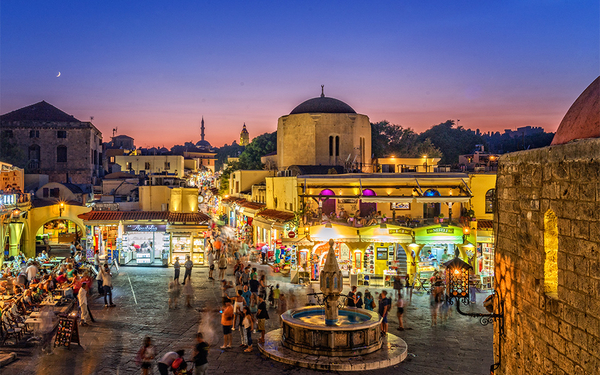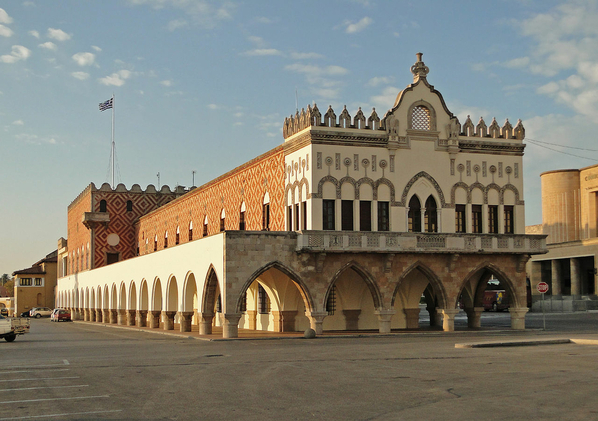Looking for a warm, or at least not freezing place for a February trip a few years ago, we decided on Athens and a Greek island, and ended up choosing Rhodes after a number of online experts and friends warned us that many islands were essentially closed for the winter, or were too far north for warmth.
Rhodes, they told us, had a deep and interesting history that could be explored, in fact best explored, when only the locals were at home, and that there were enough of them that we would find food and drink and things to do.

That sounded good to us: we're not the sort of people who are looking for crowded beaches, loud nightlife and too much to drink, which, of course, is the reputation of some of the islands in summer, including Rhodes. The contrast between the two pictures above pretty much tells that story! They're at right angles to each other, but the fountain should help place the scene. The next scene is around the corner; most of those stores only open in season.
But there was plenty to see; the Old Town area of Rhodes has been a notable town for over 2,400 years, with civilization after civilization, nation after nation building, tearing down, building again. Just across from our small hotel, we could see down a couple of dozen centuries in open excavations.
In the 20th century, Rhodes, and the other islands of its group, the Dodecanese, changed hands several times. In 1912, Italy seized the islands from a faltering Ottoman Empire, which had held the islands since shortly after the fall of Constantinople. And then, in 1943, when Italy surrendered to the Allies, German troops seized Rhodes, followed by a British occupation and finally, in 1947, a return to Greek rule for the first time in hundreds of years.
During the Ottoman era, official proclamations were read from the balcony.
Each succeeding wave (and just for clarity we'll leave out the few hundred years before 1300, because the constantly shifting alliances with different Greek states, with Rome, with Persia, the Byzantine Empire, with Egypt and sometimes back again, are just too much to think about) has left its mark, not only in the physical city, but in its population; while the main religion is Greek Orthodox, there are perhaps 4000 Rhodian Muslims, and until the German occupation, there was a significant Jewish community.
But arguably, the group that left the strongest mark on the island and especially on the city of Rhodes, were the Crusader Knights Hospitaller, or more formally, the Order of Knights of the Hospital of Saint John of Jerusalem, who came to Rhodes after being forced out of Jerusalem; they stayed in Rhodes until they were forced to move again, becoming the Knights of Malta.
In their 200-year rule of the island, the knights, who were organized into different groups based on which European language and land they were connected to, built the walls and fortifications and major buildings that shape what we see today. The long road above, Street of the Knights, is lined with the different inns the knights lived in; the inns themselves came to be called 'tongues' because of the language divisions.
True to their name, they built a hospital, seen above. It also served as an armory, and these days houses the island's archaeological museum.
But the grandest of their buildings, the Palace of the Grand Master, lies at the end of the Street of the Knights, inside a walled compound; like almost everything else they built, it was a fortification as well.
The fortifications served them well; After the fall of the Byzantine Empire, the new rulers of what is now Turkey decided to make the islands theirs as well, with Rhodes only about 11 miles off the Turkish coast. After a first attempt failed, a Turkish force of 100,000 succeeded, after a siege, in driving out the 7,000 knights.
By the time of Italian rule, many of the Knights' buildings, including the Hospital and the palace were in poor condition after centuries of use for other purposes. That we see them in such good condition today has an irony to it, as well as the only plaque I've seen anywhere honoring Benito Mussolini. The Italian dictator wanted not only to 'Italianize' Rhodes and its neighbors, he saw it as a place for a villa for the king and a retirement home for himself. Neither plan came to fruition, but important buildings were restored, including the palace.
The plaque notes that the work was done in the reign of 'His Majesty Vittorio Emanuele III, King of Italy and Albania and Emperor of Ethiopia" and during the time of Mussolini's being Leader of Fascism and Head of Government. It also gives credit below to the local Italian governor.
Questions have been raise how accurate the restoration of the interiors is, but that seems a quibble, since there are few contemporary sources to follow.
Near the Palace, the Suleiman Mosque marks the Turkish conquest; the original was built just after the 1522 conquest, to mark the victory, and then rebuilt and remodeled in 1808. The other building has a more confusing history; it's commonly referred to as the 'medieval clock tower.' Legend has it that one of its jobs was to 'teach the Greeks Turkish time,' or curfew.
But there's nothing medieval at all about the clock tower! It was built during Byzantine rule in the 7th century, and is one of the oldest buildings in use on the island. It was damaged in an earthquake in 1856 and was rebuilt with baroque elements added. I've found no information on when the clock was added, but it certainly wasn't there originally!
Away from the monumental buildings, the streets vary quite a bit from each other, often offering surprising bits of new built onto a base of old. And surprises lurk: At the bottom of this small road is the entrance to an open-air theater built into the former moat at the base of the wall. It operates in summer, and is named for former Greek Culture Minister/Activist/Actress Melina Mercouri.
Near the gate to the port area, a number of the medieval streets are arched; a few of the arches have parts of buildings on them, but most not. I haven't found a conclusive answer for the arches which exist in a number of other medieval cities; the one I like best is that they allowed covering the streets with gauzy cloth to block hot sun.
On a rainy night, with no traffic, spaces and shapes can lose their sense of time; it's different in the daylight! Below, another ingenious adaptation. The store that opens to the front of the building needed light, so they simply carved a window through the wall.
Two interesting gates, one guarding a seemingly impossibly steep marble staircase. Perhaps in an Escher drawing...
The sheer mass—size and thickness—of the fortifications makes it clear why, after the first Turkish invasion in 1480, the project was put aside until a truly massive force could be assembled. And even then, the walls largely held; it was the pleas of the townspeople, who feared starvation and fire within the walls, that induced the knights to surrender. Below, one of the ports in the wall now houses souvenir shops.
Outside the walls of the Old Town is where the Italian occupation made itself most felt architecturally, other than the medieval restorations. Along the harbor, they built the Church of the Annunciation, intended as a home for Italian Catholics who, it was hoped, would 'Italianize' the population. Blending a variety of historic styles including Venetian, Gothic and Baroque, it was turned over to the Orthodox community in 1948, and is now the Cathedral of Rhodes.
An even more flamboyant mixture of Mussolini-era architectural nostalgia is the Governor's Palace, now the offices of the Prefecture of the Dodecanese. It clearly shows at the very least Venetian and Moorish influences and a bit of others as well.
And last, a theatre built to present Italian plays. Quite simple and nearly unadorned it combines hints of Greek pillars with Art Deco forms and proportions, overlaid, or perhaps stripped down to, Bauhaus spareness.
Once again, looking back at a short trip has made me wish for a longer one. There's more to explore, both within and without the walls—and the town itself is only a small part of a large island. One day...




Comments (0)